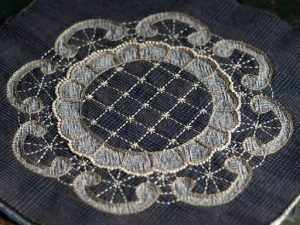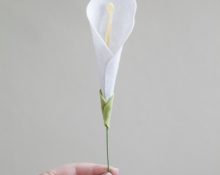
creativecommons.org
Welt applique on fabric is also called reverse decorating method. With its help you can make a unique design of clothing or interior items. The essence is to place fabric under the main material from which the item is made. Afterwards, original shapes, ornaments and pictures are cut out on the base, through which the lower canvas of a different shade can be seen.
Welt applique is the sewing of new fabric onto a base material for the purpose of cutting out decorative elements. It can be done not only on fabrics, but also on paper. During the work process, it is important to correctly outline all surfaces. When cutting out shapes, you need to be extremely careful to ensure that the outlines remain smooth. The applique will not only decorate clothes, it will help get rid of stains, holes or defects on things. The cut-out or reverse decoration method is widely used by fashion designers and fashion designers.
Cut-out applique on fabric - master class

creativecommons.org
The short process is to create cuts in the top fabric that will reveal the bottom material. Layers of canvas are placed on top of each other, then images are drawn on the upper fabrics and cut out along the contours. For example, decorating a black T-shirt using delicate fabric in flowers or other patterns will give the item a romantic, feminine motif. There must be a stitch on the cuts, otherwise the fabric will begin to crumble over time. How to make reverse appliqué on clothing:
- Redraw the drawing onto the main material.
- Make a pattern for the first bottom layer. Size – identical to the size of the main part or slightly larger than the pattern itself.
- Lay out the bottom layer so that the pattern is in the center. The main fabric is on top. Baste the fabric two centimeters from the ends of the pattern.
- Cut through the top layer of fabric using sharp nail scissors. Preliminarily count seven millimeters from the edge of the pattern where the elements of the lower fabric will be located.
- Cut corners and curved edges so that the material lies flat and does not wrinkle near the hems.
- Fold the main fabric along the edges of the design using the tip of a needle. For hemming, use a blind stitch. Choose the colors of the threads so that they are almost invisible against the background of the fabric. If necessary, trim the bottom fabric a centimeter from the seam. This will make the application thinner.
- Baste the second lower fabric to the wrong side of the item. Make holes in the main and first bottom fabric. They should be located where it is planned to highlight the material of the second lower layer. This can be embroidery, lace, inscription and other decorations.
- The next step is to fold the second bottom layer at the edges and sew them. A hidden stitch is used. You can add a few more layers of materials of different colors, then remove the basting stitches.
- Trim the remaining fabric or sew it all together at the edges. Transfer the design to the top layer, fold all the canvases in the correct sequence, and sweep away.
- Additionally, you can decorate products using stripes, shiny materials or patterns. Rhinestones, stones or braid are often placed along the contour of the holes. Raw cut edges look stylish today.


 0
0





